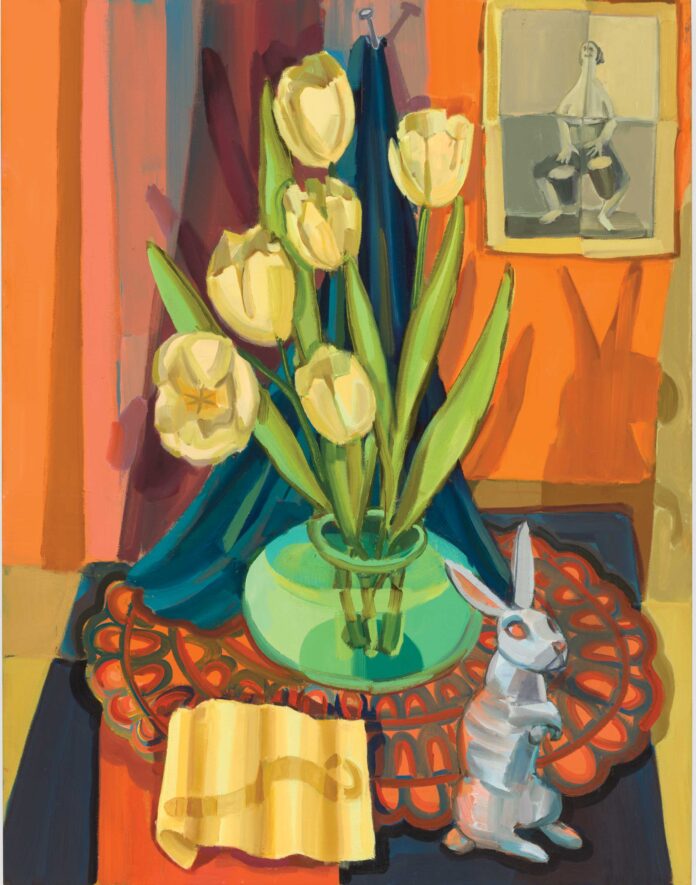
Art Collection Spotlight > Ever since Dennis Elliott met the artist Judith Linhares in 1978, he has followed her work, along with the white rabbit she has frequently included in her paintings. Like Alice who chased that animal down the hole into Wonderland, Elliott, a prolific artist himself as well as the founder of the International Curatorial Studio Program (ICSP), has followed the progression of scenes Linhares paints and produces in her Brooklyn studio.

“Much of her work is a bit like what you’d find in Wonderland, as if Lewis Carroll might have constructed his stories in paint,” says Elliott, who in 1994 founded ICSP, an influential nonprofit which, to date, has brought some 2,500 mid-career artists from 88 countries to New York City for residencies.
While Elliott has long admired the fantastical nudes for which Linhares is best known, he has developed a particular penchant for her still lifes. This work above, “Go Tell Alice” (2022), represents exactly what Elliott most admires about Linhares’s canvases. “It’s very lush, it’s radiant, it’s easy to like, it’s delicious,” he says. “I consider her flower paintings second only to Van Gogh’s, though I have to admit I like hers even better.”
Although Linhares has had a successful career as an artist and teacher since she moved to New York from her native California in the 1970s, she has long been regarded as “an artist’s artist,” Elliott observes. But with a solo show at Florida’s Sarasota Art Museum in 2022, multiple shows and ongoing representation at the New York gallery P.P.O.W., and a solo show in 2023 at London’s Massimodecarlo, Linhares is increasingly known to a wider public.
Elliott particularly admires her ability to paint still lifes from memory. “In that sense, this painting and others are very un-still life,” he says, noting that it wasn’t until the early 1990s that she embraced the genre as one of her preferred forms. “With this particular work by Judy, there are references that draw people into the painting right away.” He points not only to the rabbit, seemingly about to hop off the canvas, but also the depiction in a corner of an iconic photograph that shows the late abstract painter and actress Deborah Remington playing a set of bongos.
“I happen to know that Deborah was a hero of Judy’s, and she likes how this photo of her represents a significant kind of freedom. What could sum up freedom more than playing the drums on a hot day on a Southern California beach with not much on?”
As a painter who describes his own canvases as “featuring forms that often look like things floating in outer space,” Elliott admires Linhares’s ability to carefully construct paintings. “She is like Van Gogh in that way,” he says, “for she understands how to develop space on a canvas and then be very attentive to brushwork. She’s always conscious of the position of the painting and where the edges of the canvas are.”
Having watched her progression over the decades, Elliott knows that paintings of hers that may look easy and spontaneous are, in fact, the result of weeks of work. “Nothing of hers is done in an afternoon. She paints and erases and takes paint away and then adds paint again. It’s a process.”
Elliott confesses that it took years for him to admire still lifes by any painter. “It came with age,” he recalls. “Normally, as a young snotty grad student at what’s now called the California College of the Arts, where coincidentally Judy was studying at the same time, though we didn’t know each other, I would have been dismissive of the genre. Now, I find great, radiantly colored still lifes like this one to be sources of solace, to be contemplative. All of Judy’s paintings provide that for me.”
View more art collection spotlights here at FineArtConnoisseur.com.







